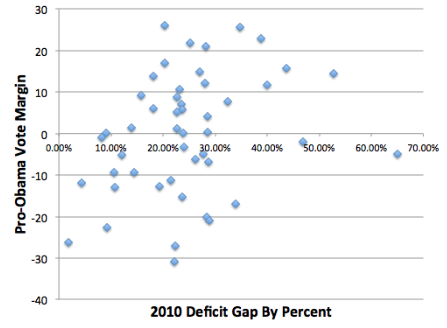There’s been a lot of discussion about how the “Blue” states seem to be suffering the most in this fiscal mess. Articles and posts like The Blue State Budget Crisis, Why is it that most of the states with massive budget problems are run by Democrats?, and Fiscal mess in blue states a problem for Dems? litter the Web.
Despite the many keystrokes dedicated to this topic, I have not encountered the authors who have taken the time to actually run the numbers and prove the obvious. I am sure that fault is my own — and that the analysis is out there — but my searches have probably been inadequate. Or then again, it could be that they just don’t feel the need. I mean when our two biggest states — ultra-blue New York and California are the poster children for bad budgeting, what more do you need?
Regardless — I have run the numbers, and if you hold a reality-based worldview similar to the Economist which recognizes that entitlements and union-driven demands are at the root of the fiscal mess our states face, and that those types of spending priorities comes more from dems, there’s nothing new here.
To measure “blueness” I used the data provided by wikipedia on how states leaned in their 2008 Obama vs McCain vote. 2010 deficit data came from the CBPP. The CBPP did not include those states in surplus (Red states Montana and North Dakota), and I decided to drop them, because I’m lazy, and wanted to be extra fair to the utopians.
Scatterplot below. As expected, it depicts a noticeable relationship. XLS file here.

Bottom line? A robust Pearson correlation of .32, without factoring in any other variables. “…social researchers would consider a coefficient of .30 or more as indication of a “strong” change when measuring human behavior…”
Other similar correlations?
“…family income is correlated +.30 with the IQ of children…”
“…meta-analysis obtained a corrected correlation of .32 between socioeconomic status and academic performance… ”

2 responses so far ↓
1 Steve Roth // Mar 6, 2011 at 10:17 am
I don’t know why I was just thinking about this post, but, prompted me to drop some numbers into your spreadsheet:
#1
• Observation: Blueness correlates with higher state budget deficits (.32) [HEY: I get .56]
• Assertion: Blueness causes higher state budget deficits
• Observation: Blueness correlates with higher GDP per capita (.52)
• Inescapable assertion, if you’re gonna claim #1: Blueness causes greater prosperity.
This is not a generic post-hoc argument. This is apples and apples. If you claim #1 is true, you have to believe that #2 is true.
We could continue this:
Observation: higher state budget deficits correlate with greater prosperity (.51)…
I’m thinking none of this teaches us anything.
2 Steve Broback // Apr 17, 2011 at 10:40 am
This from the man who doesn’t see simultaneity between prosperity and the development of a welfare state.
As the king of scatterplots, I’m surprised that you find nothing interesting about this correlation. On the other hand, as an enthusiastic advocate for European style social democracy, I’m not surprised that you prefer to ignore it. The level of cognitive dissonance required to so is somewhat striking though.
Hard to make a case for simultaneity when it’s the elected politicians who decide the policies for generating revenue and for the levels of expenditures.
Ask a broad universe of economists or politically neutral adults if the logical conclusion here is that fiscal choices cause blueness or the other way around, I think it’s clear which would trump.
We finally find a logical case where we can assert a reasonable condition of “all other things being equal” (unlike the perpetually generated OECD correlations being cranked out) and your response is Christmas trees in houses might very well cause Christmas.
Hey, whatever gets you through the day…
Leave a Comment